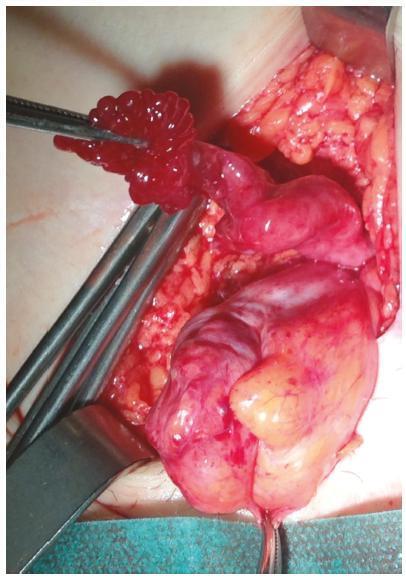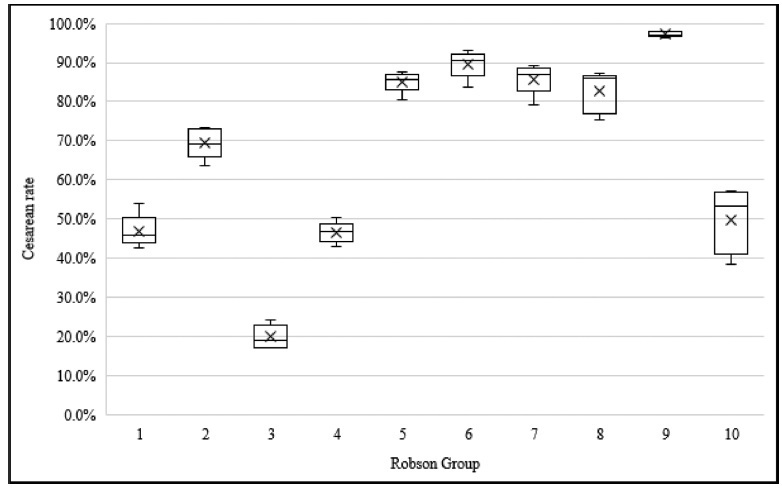Summary
Revista Brasileira de Ginecologia e Obstetrícia. 2019;41(8):520-522
Femoral hernias comprise a small proportion of all groin hernias. They are more common in women and have a high rate of incarceration and strangulation, leading to emergency repair. A 61-year-old female patient was admitted to the emergency department complaining of a 2-day painful lump in the right groin, that had become more intense in the last 24 hours. Physical examination suggested the presence of a strangulated femoral hernia, and the patient underwent emergency surgical repair. Intraoperatively, the right fallopian tube was observed in the hernia sac. Since there were no signs of ischemia, the tube was reduced back into the pelvic cavity and the hernia was repaired. The postoperative period was uneventful, and the patient was discharged without complications, 3 days after surgery.

Summary
Revista Brasileira de Ginecologia e Obstetrícia. 2015;37(11):520-525
DOI 10.1590/SO100-720320150005438
To translate, to adapt and to validate the Utian Quality of Life (UQOL) for the Brazilian population.
Women in the climacteric phase, residents in the city of Natal, Rio Grande do Norte, located in the Brazilian Northeast, were randomly selected. UQOL and SF-36 questionnaires were used, and the translation from English to Portuguese was made by three teachers, while the adaptation stage of the translated version was made by applying the questionnaire to 35 women, which could mark the answer choice "I did not understand the question"; reproducibility measurements (test-retest) and construct validity were used to validate, following international methodological standards.
The Brazilian version was fully recognized by the target population, which was comprised of 151 women, as no question showed a percentage of "non-understanding" equal to or greater than 20%. The results for intra and interobserver reproducibility demonstrated significant agreement on all the questionnaire items. This version showed consistency above the required criteria (>70), demonstrating its accuracy, while the construct validity was obtained by statistically significant correlations between the domains occupation, health and emotional of UQOL and the SF-36 domains. The Cronbach's alpha coefficient for the whole instrument was 0.82, representing good accuracy. Item-total correlation analysis showed the scale homogeneity
From the steps taken, the UQOL questionnaire was translated and adapted for its use in Brazil, with high reproducibility and validity. Thus, it can be included and used in Brazilian studies that aim at evaluating the quality of life of women during the peri- and postmenopausal.
Summary
Revista Brasileira de Ginecologia e Obstetrícia. 2010;32(10):520-520
Summary
Revista Brasileira de Ginecologia e Obstetrícia. 2017;39(10):521-522
Summary
Revista Brasileira de Ginecologia e Obstetrícia. 2002;24(8):521-526
DOI 10.1590/S0100-72032002000800004
Purpose: to assess the evolution of epileptic seizures during pregnancy and the occurrence of malformations in neonates born to epileptic mothers who used anticonvulsant drugs during pregnancy, as well as the perinatal characteristics of the newborns. Methods: a total of 126 medical records of epileptic patients seen at the high-risk pregnancy outpatient clinic were analyzed retrospectively in terms of the following variables: age, parity, diagnosis of the type of epileptic seizure, anticonvulsant drug used during the prenatal period, evolution of epileptic seizures during the prenatal period, type of delivery, gestational age at resolution, and perinatal characteristics of the newborns. Results: the incidence of pregnant women with epilepsy was 0.2% in relation to prenatal patients, with simple partial epilepsy being the most frequent type (40% of cases). Monotherapy was applied to 75% of the patients and carbamazepine was the most frequently used drug. Among the 111 patients evaluated in terms of course of the disease during pregnancy, 53% showed no change, 31% became worse and 16% improved. Normal delivery was performed in 62.5% of cases, with a satisfactory perinatal result in terms of Apgar score, and with a rate of low birth weight neonates above the values for low-risk populations. No fetal malformations were observed. Conclusion: epilepsy showed a favorable course during pregnancy and was not aggravated by the latter, with cases of worsening of signs and symptoms being associated with epilepsy of difficult control before pregnancy. Evaluation of the perinatal characteristics of the neonates showed satisfactory Apgar scores and evolution, indicating that epilepsy and anticonvulsant drugs do not cause severe impairment of intrapartum vitality. No cases of malformations or hemorrhagic complications were detected in the present study.
Summary
Revista Brasileira de Ginecologia e Obstetrícia. 2020;42(9):522-528
To obtain cesarean-section (CS) rates according to the Robson Group Classification in five different regions of Brazil.
A descriptive epidemiological study using data from secondary birth records fromthe Computer Science Department of the Brazilian Unified Health System (Datasus, in Portuguese) between January 1st, 2014, and December 31st, 2016, including all live births in Brazil.
The overall rate of CSwas of 56%. The sample was divided into 11 groups, and vaginal births were more frequent in groups 1 (53.6%), 3 (80.0%) and 4 (55.1%). The highest CS rates were found in groups 5 (85.7%), 6 (89.5%), 7 (85.2%) and 9 (97.0%). The overall CS rate per region varied from 46.2% in the North to 62.1% in the Midwest. Group 5 was the largest obstetric population in the South, Southeast and Midwest, and group 3 was the largest in the North and Northeast. Group 5 contributed the most to the overall CS rate, accounting for 30.8% of CSs.
Over half of the births in Brazil were cesarean sections. The Midwest had the highestCS rates,while theNorth had the lowest. The largestobstetric population in the North and in the Northeast was composed of women in group 3, while in the South, Southeast and Midwest it was group 5. Among all regions, the largest contribution to the overall CS rate was from group 5.

Summary
Revista Brasileira de Ginecologia e Obstetrícia. 2021;43(7):522-529
To assess the sexual function and associated factors in postmenopausal women.
This a descriptive, cross-sectional study with 380 women aged 40 to 65 years, users of public health services in 2019. Questionnaires were applied on demographic characteristics, on climacteric symptoms (menopause rating scale) and on sexual function (sexual quotient, female version). Bivariate andmultiple analyses by logistic regression were performed, with adjusted odds ratios (ORad) and 95% confidence intervals (95%CIs).
More than half (243/64%) of the participating women were at risk of sexual dysfunction, with lower scores in the domains of sexual desire and interest, comfort, orgasm, and satisfaction. Women with a partner (ORad 2.07; 95%CI 1.03-4.17) and those who reported sleep problems (ORad 2.72; 95%CI 1.77-4.19), depressed mood (ORad 2.03; 95%CI 1.32-3.10), sexual complaints (ORad 8.16; 95%CI 5.06-13.15), and vaginal dryness (ORad 3.44; 95%CI 2.22-5.32) showed greater chance of sexual dysfunction.
There was a high prevalence of sexual dysfunction, with the influence of conjugality and climacteric symptoms on sexual function.
Summary
Revista Brasileira de Ginecologia e Obstetrícia. 2017;39(10):523-528
To assess cases of labor induction with vaginal 25-μg tablets of misoprostol and maternal outcomes in a tertiary hospital in southeastern Brazil.
This was a retrospective cohort study of 412 pregnant women with indication for labor induction. Labor induction was performed with vaginal 25-μg tablets ofmisoprostol in pregnant women with Bishop scores < 6. Stepwise regression analysis was used to identify the factors present at the beginning of induction that could be used as predictors of successful labor induction.
A total of 69% of the pregnant women who underwent labor induction progressed to vaginal delivery, and 31% of the women progressed to cesarean section. One or two misoprostol tablets were used in 244 patients (59.2%). Of the 412 patients, 197 (47.8%) required oxytocin later on in the labor process, after induction with misoprostol. The stepwise regression analysis showed that only Bishop scores of 4 and 5 and previous vaginal delivery were independent factors with statistical significance in the prediction of successful vaginal labor induction (β = 0.23, p < 0.001, for a Bishop score of 4 and 5, and β = 0.22, p < 0.001, for previous vaginal delivery).
Higher Bishop scores and previous vaginal delivery were the best predictors of successful labor induction with vaginal 25-μg tablets of misoprostol.